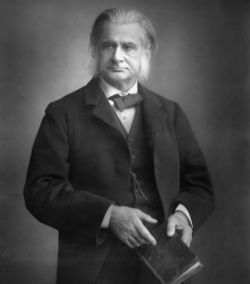Thomas Henry Huxley

- Born
- 4 May 1825
- Died
- 29 June 1895 (age 70)
Thomas Henry Huxley was a renowned anatomist, naturalist, agnostic and advocate for the teaching of science in schools. He rose from humble beginnings to become the President of the Royal Society. While being a highly proficient biologist in his own right, Huxley’s greatest legacy was probably his advocacy for evolution, as well as the secularisation of science and, to a lesser extent, British society as a whole.
Born in Ealing, Huxley was largely self-taught as his family were too poor to pay for his education. The first major step in his career was his voyage on the HMS Rattlesnake to Australia and New Guinea. Like Charles Darwin, he collected specimens on his trip.
While Darwin is rightfully credited with the theory of evolution, it was Huxley who defended the theory during the scientific and religious storms that followed the publication of On the Origin of Species. During his 1860 Oxford debate with Bishop Samuel Wilberforce, Huxley famously rebuffed a jibe by responding that he would “not be ashamed to have a monkey for his ancestor, but he would be ashamed to be connected with a man who used his great gifts to obscure the truth.”
Likewise, Huxley also took on Wilberforce’s scientific mentor, renowned naturalist Sir Richard Owen. Owen was agitated by the idea that man was little more than an advanced animal, and proposed that humans were an entirely unique branch of mammal. This outraged Darwinists at the time, with Darwin himself saying "Man... as distinct from a chimpanzee [as] an ape from a platypus... I cannot swallow that!" It was Huxley; however, who proved Owen wrong by demonstrating the anatomical similarities between apes and humans in what is now called the Great Hippocampus Debate. In fact, in his populist book Man's Place in Nature, he dived into the topic of man’s origins a decade before Darwin did in Descent of Man.
Despite his moniker as ‘Darwin’s Bulldog’, Huxley was a distinguished biologist in his own right. The majority of his work focused on studying marine invertebrates through comparative anatomy. Notably, he illuminated the relationship between the various groups of cnidarians (jellyfish, anemones and corals), solved the mystery of the sea creature Appendicularia’s place in the animal kingdom and published papers on morphology, including that of squid and muscles.
Later on in life, Huxley ventured into vertebrate anatomy. He was one of the first to suggest that birds were related to dinosaurs from his study of fossils such as the Archaeopteryx, an animal from the Late Jurassic that possessed features of both dinosaurs and birds.
Above all else, Huxley was a sceptic and demanded empirical proof before subscribed to an idea. This prompted not only his agnosticism, but also some dispute with Darwin over the theory of natural selection. Huxley promoted rigorous learning within his own family and two of his grandsons, Julian and Andrew, went on to become prominent biologists. Another of his grandsons, Aldous Huxley, was the great author most famous for his novel Brave New World.
This profile was written by a Biology: Changing the World volunteer.



